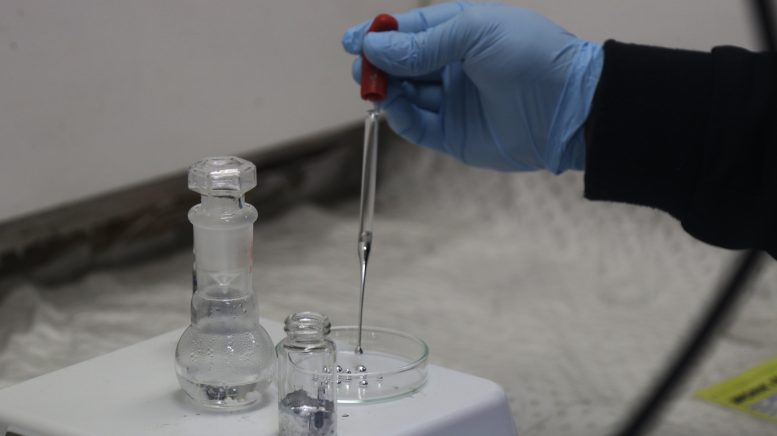A new technique using liquid metals as catalysts promises to revolutionize the chemical industry by enabling low-temperature, energy-efficient chemical reactions, potentially reducing greenhouse gas emissions and energy use. Above is liquid gallium in a Petri dish. Credit: University of Sydney/Philip Ritchie
The chemical industry is presented with an “unparalleled possibility” to alter the future of chemical processes.
Liquid metals could be the long-awaited solution to “greening” the chemical industry, according to researchers who tested a new technique they hope can replace energy-intensive chemical engineering processes harking back to the early 20th century.
Around 10-15% of global greenhouse gas emissions stem from chemical manufacturing. Additionally, chemical plants consume over 10% of the world’s energy.
Findings recently published in Nature Nanotechnology offer a much-needed innovation that moves away from old, energy-intensive catalysts made from solid materials. The research is led by Professor Kourosh Kalantar-Zadeh, Head of the University of Sydney’s School of Chemical and Biomolecular Engineering, and Dr Junma Tang, who works jointly at the University of Sydney and UNSW.
Propylene generation using liquid gallium. Credit: Dr. Junma Tang
A catalyst is a substance that makes chemical reactions occur faster and more easily without participating in the reaction. Solid catalysts, typically solid metals or solid compounds of metals, are commonly used in the chemical industry to make plastics, fertilizers, fuels, and feedstock.
However, chemical production using solid processes is energy-intensive, requiring temperatures of up to a thousand degrees centigrade.
The new process instead uses liquid metals, in this case dissolving tin and nickel which gives them unique mobility, enabling them to migrate to the surface of liquid metals and react with input molecules such as canola oil. This results in the rotation, fragmentation, and reassembly of canola oil molecules into smaller organic chains, including propylene, a high-energy fuel crucial for many industries.

Placing liquid gallium in a Petri dish via syringe. Credit: University of Sydney/Philip Ritchie
“Our method offers an unparalleled possibility to the chemical industry for reducing energy consumption and greening chemical reactions,” said Professor Kalantar-Zadeh.
“It’s expected that the chemical sector will account for more than 20 percent of emissions by 2050,” said Professor Kalantar-Zadeh. “But chemical manufacturing is much less visible than other sectors – a paradigm shift is vital.”
How the process works
Atoms in liquid metals are more randomly arranged and have greater freedom of movement than solids. This allows them to easily come into contact with, and participate in, chemical reactions. “Theoretically, they can catalyze chemicals at much lower temperatures – meaning they require far less energy,” Professor Kalantar-Zadeh said.
In their research, the authors dissolved high-melting point nickel and tin in a gallium-based liquid metal with a melting point of only 30 degrees centigrade.

Dr. Junma Tang (left), Dr. Arifur Rahim (center), and Professor Kourosh Kalantar-Zadeh (right). Credit: University of Sydney/Philip Ritchie
“By dissolving nickel in liquid gallium, we gained access to liquid nickel at very low temperatures – acting as a ‘super’ catalyst’. In comparison solid nickel’s melting point is 1455 degrees centigrade. The same effect, to a lesser degree, is also experienced for tin metal in liquid gallium,” Dr Tang said.
The metals were dispersed in liquid metal solvents at the atomic level. “So we have access to single-atom catalysts. Single atom is the highest surface area accessibility for catalysis which offers a remarkable advantage to the chemical industry,” said Dr Arifur Rahim, senior author and DECRA Fellow at the School of Chemical and Biomolecular Engineering.
The researchers said their formula could also be used for other chemical reactions by mixing metals using the low-temperature processes.
“It requires such low temperature to catalyze that we could even theoretically do it in the kitchen with the gas cooktop – but don’t try that at home,” Dr. Tang said.
Reference: “Dynamic configurations of metallic atoms in the liquid state for selective propylene synthesis” by Junma Tang, Andrew J. Christofferson, Jing Sun, Qingfeng Zhai, Priyank V. Kumar, Jodie A. Yuwono, Mohammad Tajik, Nastaran Meftahi, Jianbo Tang, Liming Dai, Guangzhao Mao, Salvy P. Russo, Richard B. Kaner, Md. Arifur Rahim and Kourosh Kalantar-Zadeh, 9 November 2023, Nature Nanotechnology.
DOI: 10.1038/s41565-023-01540-x


